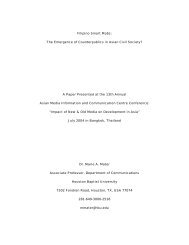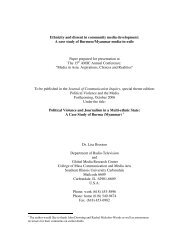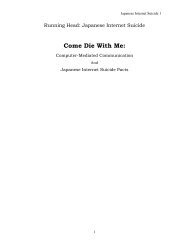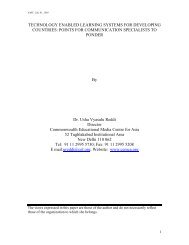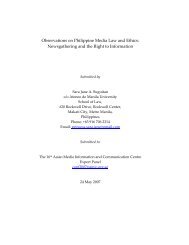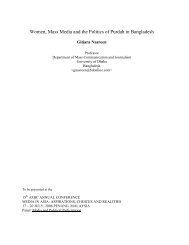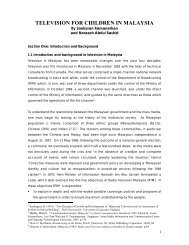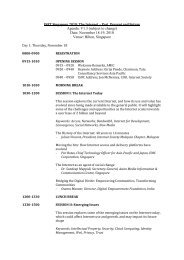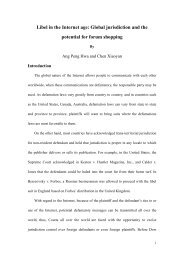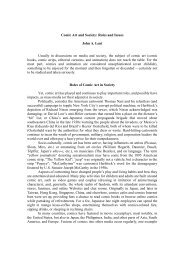Exploring Young Men Gender Constructions - The Asian Media ...
Exploring Young Men Gender Constructions - The Asian Media ...
Exploring Young Men Gender Constructions - The Asian Media ...
You also want an ePaper? Increase the reach of your titles
YUMPU automatically turns print PDFs into web optimized ePapers that Google loves.
Kasari-sarian ng Kalalakihan (<strong>The</strong> Multiplicity of Manhood):<br />
<strong>Exploring</strong> <strong>Young</strong> <strong>Men</strong>’s <strong>Gender</strong> <strong>Constructions</strong><br />
And <strong>The</strong>ir Serial Drama Connections<br />
By<br />
Brian S. Bantugan<br />
U.P. College of Mass Communication<br />
and<br />
St. Paul University Manila<br />
Mass Communication Program
<strong>The</strong> Philippines saw a resurgence of serial dramas in national television in the<br />
early 1990’s. <strong>The</strong> first soap opera to gain wide mass appeal after more than ten years of<br />
dry spell was “Mara Clara.” <strong>The</strong> story reveals two adolescent girls in a twist of fate. A<br />
poor girl, Mara, discovers that she is an adopted child and begins to look for her real<br />
parents. Clara, a rich heiress, also finds out that she is adopted and that Mara is the<br />
legitimate child. Realizing that Mara can take away everything that she has, Clara does<br />
everything to hide the truth – kept by a missing diary. <strong>The</strong> program lasted years. Women,<br />
young and old, saw the lead characters and actresses grow up before their eyes. But also<br />
did a lot of soon-to-be-men. But Mara Clara was only one of the many serial dramas the<br />
boys grew up with. <strong>The</strong>y also watched “Esperanza” (Hope) and “Mula sa Puso” (From<br />
the Heart), now classic serial dramas whose main actresses have now become premiere<br />
stars in Philippine entertainment. Growing up to adolescence they watched second<br />
generation drama serials, most of which were driven by female protagonists, and all<br />
backed up by a dominantly female cast. “Pangako sa ‘Yo” (My Promise to You),<br />
“Sana’y Wala Nang Wakas” (Hoping <strong>The</strong>re’s No End), “Basta’t Kasama Kita” (As Long<br />
as We’re Together), “Recuerdo de Amor” (Memories of Love), “Kay Tagal Kang<br />
Hinintay” (Long Have I Waited For You) and “Marina” (Marina, <strong>The</strong> Mermaid) – love<br />
stories all – captured the hearts of the now new male media professionals who graduated<br />
from private sectarian, private non-sectarian and public higher education institutions in<br />
Metro Manila.<br />
But that’s not the complete picture. Some of them also watched American Drama<br />
series like “L.A. Law”, a legal drama; “Picket Fences”, a police drama; “Boston Public”
and “Felicity”, school dramas; “Wonder Years”, a family drama; “Buffy” and<br />
“Charmed”, supernatural dramas; and “Robotech”, a science fiction cartoon serial. More<br />
recently, Argentina gave them “Monica Brava” (Monica <strong>The</strong> Brave), South Korea<br />
delivered “Irene” (<strong>The</strong> Mermaid) and Cantonese China sold the phenomenal “Meteor<br />
Garden”. <strong>The</strong> Filipino-dubbed Spanish, South Korean and Chinese serial dramas continue<br />
to invade Philippine airwaves and serial dramas continue to fill Philippine primetime<br />
programming with more and more soap operas. But for most people in the academe and<br />
research, there was only the female audience for such programs. “Kasari-sarian ng<br />
Kalalakihan (<strong>The</strong> Multiplicity of Manhood): <strong>Exploring</strong> <strong>Young</strong> <strong>Men</strong>’s <strong>Gender</strong><br />
<strong>Constructions</strong> and <strong>The</strong>ir Serial Drama Connections” was able to recognize that research<br />
work has been limited in its study of the genre as much as it has been limited in its<br />
assumption, if not knowledge, of television audiences, especially in a society such as the<br />
Philippines. <strong>The</strong> connection between male audiences and serial dramas lies deeper<br />
than a desire for entertainment. It lies at the very core of a man’s being – in the<br />
union of his mind and heart - in his gender - which society helps construct.<br />
This pursuit to determine the breadth and depth of connections between the<br />
gender constructions of male serial drama viewers and the serial drama they prefer and<br />
consume, involved male college students from three types of higher educational<br />
institutions, enrolled in mass communication courses and recommended by their<br />
academic heads and peers. Mass Communication students were sought since their<br />
storytelling capacities may point to future directions in television narratives should they<br />
successfully penetrate the television industry after graduation. Using a qualitative
esearch design that combined a short survey on each participant’s sexual experiences<br />
and/or preferences, brainstorming and collective narrative creation activity and in-depth<br />
participant interview, the investigation hoped to gain access to rich and multi-layered<br />
narratives that can indirectly and/or directly reveal their gender constructions and their<br />
interactions with particular serial dramas they watched from childhood until the time of<br />
the investigation. Using reception and textual analysis, their narratives were sorted and<br />
classified within a unified sex-gender system framework in mind. <strong>The</strong> framework<br />
integrated one’s sex, sexual activity and/or preference using the Kinsey Seven-Point<br />
Scale, gender identification in the BSMRI <strong>Media</strong>n Split <strong>Gender</strong> Identification Categories<br />
and personality traits of the Revised NEO Personality <strong>The</strong>ory with the assumption that<br />
human beings strive for a paradigm consistency to help them cope more effectively and<br />
efficiently as integrated persons with situations that call for a strength in conviction and<br />
psycho-emotional stability.<br />
Figure 1. Sex-<strong>Gender</strong> Complicite<br />
(Bantugan, 2005)<br />
Figure 2. Sex-<strong>Gender</strong> Continuum<br />
Measures (Bantugan, 2005)
Likewise, knowing that narrative creation is both a personal and social experience<br />
often influenced by one’s media exposure, the research established the “Co-determinant<br />
Narrative Reference Analysis Design” or CoNRAD as a tool that can help verify<br />
consistencies in and among personal and collective narratives which is crucial in<br />
determining the connections that lay inherent in the serial drama viewership of young<br />
men. What gender constructions link viewers and programs, viewers and characters and<br />
viewers with fellow viewers, if any How connected are the gender links <strong>The</strong>se two<br />
questions fueled the inquiry.
<strong>The</strong> results confirmed that connections between viewer and program or vertical<br />
connections, viewer and character or vertizontal connections and viewer and fellow<br />
viewer or horizontal connections exist. <strong>The</strong> fact that most of the participants were<br />
exclusive-heterosexuals disproved the notion that only men who have tendencies<br />
towards non-exclusive heterosexuality are the most predisposed to serial dramas.<br />
Exclusively-heterosexual or otherwise, the male participants are connected to serial<br />
dramas they watched at different levels, except for one in 30 who was generally<br />
unconnected to fictional narratives on television. At the lowest connection level with<br />
serial dramas, are those with limited exposure but having no intention of paying attention<br />
to them. A notch higher in vertical connection are those with limited exposure with the<br />
genre but having significant interest with the more unconventional ones. A little more<br />
vertically connected are those with limited viewing but a growing interest in the story,<br />
cliffhangers, lead or suffering characters and artists in any type of serial drama. Another<br />
type of vertical connection appears in a participant who keeps himself open to any type of<br />
serial dramas despite his limitations in viewing opportunities. A stronger connection is<br />
made manifest by those who have clear attachments to a particular serial drama and<br />
transcend any viewing limitation. Finally, the strongest connection appears in a<br />
participant whose personal engagement in every episode of a particular serial drama is<br />
regular and intense.
All non-exclusive heterosexuals established a clear although varied vertical<br />
connectedness with the genre. On the other hand, the exclusive heterosexuals outnumber<br />
the former in terms of serial and series drama viewership. And yet, those who prefer<br />
series dramas (once-a-week) – mostly American in origin – are those who claim<br />
exclusive heterosexuality or exclusive homosexuality (or those at the poles of the Kinsey<br />
scale). Such viewers have sustained viewership despite longer gaps between episodes.<br />
Those who are in between the Kinsey poles or having varying incidence of heterosexual<br />
and homosexual experiences constitute more the mostly locally and non-American made<br />
serial (or daily installment) drama viewers. Although exceptions exist, there seems to be<br />
a correlation between American series dramas and Kinsey pole viewers and local and<br />
non-American made serial dramas and Kinsey non-pole viewers. Does it in any way<br />
mean that Filipino, <strong>Asian</strong> or Latin American serial dramas establish more<br />
connections with viewers with variant sexual preferences Inversely, do viewers<br />
with variant sexual preferences connect more with non-American serial narratives<br />
New entry points for investigation now emerge. Despite these questions, however, it<br />
was clear that most of them gave more attention to narrative format than<br />
relationship, character traits or values found in the serial dramas they watched –<br />
revealing a high stimulation from and significant concern for how a narrative is<br />
told.<br />
<strong>The</strong> investigation related to vertizontal or viewer-character connections,<br />
meanwhile, showed that, except for one of them who identified with a masculine female<br />
character, they all connected with male characters whose ages are within the adolescence
and middle adulthood range. <strong>The</strong> highly conscientious, moderately extraverted and open<br />
and mildly neurotic and agreeable participants reveal a detached viewing style that is<br />
driven by strength in deliberation. However, deliberation is more enduring or immediate<br />
in the area of narrative format than personal aspects like character traits, values or<br />
relationships which are more attached to women viewers or characters. Have the past<br />
and current series and serial dramas viewed by the participants represented men<br />
enough, enough to make them lead characters and not mere support to women<br />
actresses, so that male viewers are more easily drawn to personal aspects rather<br />
than technicalities in narratives While the programs cited by the participants<br />
clearly indicate NO as the answer, it has yet to be strengthened with experiences of<br />
more male viewer informants. <strong>The</strong> fact remains, though, that females as lead<br />
characters in series and serial dramas do not discourage male viewers to view the<br />
genre and seek identification with other characters who are primarily extraverted in<br />
terms of assertiveness, and conscientious in dutifulness and deliberation. In effect,<br />
while the vertizontal connection of series and serial dramas with the male<br />
participants is founded initially on the sex, and correlated to a limited extent to the<br />
sexual preference, of the character they identify with, the personality traits of<br />
characters which the viewers also possess strengthen it and the vertical connections,<br />
as well.<br />
<strong>The</strong> participants, being highly individuated and varying in their viewing<br />
preferences and recall, lack a community built upon a common series or serial drama.<br />
<strong>The</strong> individuation is influenced significantly by family members and situations, personal
needs, and high deliberation on narrative format. If any, possible horizontal connection<br />
could be established more at the categories of series or serial dramas or local or foreign<br />
serialized dramas. <strong>The</strong> participants’ composite narratives, however, revealed a narrative<br />
community built on themes revolving around the male social condition. <strong>The</strong> isolation of<br />
men was expressed as emotional separation from a life-companion, detachment from<br />
one’s past or origin, rejection from one’s roots and the gap between the real and ideal in<br />
one’s life. Faulty fatherhood, told in the person of a dependent husband, deceptive,<br />
destructive and spoiler fathers and an absentee image in narratives, also drove the<br />
conflicts or problems in the composite narratives. Minimized motherhood was also a<br />
distinct theme in the composites that manifested as mothers suddenly disappear or die,<br />
supporting female characters are not made wives or mothers and limit themselves to mere<br />
objects of desire of lead male characters and lead female characters are rendered unable<br />
to consummate a relationship due to psychological incapacity. Finally, enlightenment was<br />
also a central theme that provided the redeeming value in the composites. As lead male<br />
characters accept their sexual orientation and those of others, recognize and share their<br />
emotional resources, follow their desire to stay connected with their past, fight the<br />
establishment and those that claim power over persons, make moral decisions, and heal<br />
themselves to heal their children, they express the desire of the participants for a more<br />
integrated existence built on resolution of situations that affect them the most. In this<br />
case, male composite narrative creation revolves around issues which may not<br />
directly involve the creators but are still considered relevant to the building of a<br />
more meaningful and peaceful life and a struggle to resolve them. Do past and<br />
present series and serial dramas which the participants have and currently watch
eflect the same desire Some participants affirm. But all of them show through<br />
their composite narratives that most of those they have viewed or watched have not<br />
placed their problems centerstage. Given the chance, a male community of<br />
storytellers will.<br />
Bibliography:<br />
Books:<br />
Aguiling-Dalisay, G., <strong>Men</strong>doza, R. M., Mirafelix, E. J. L., Yacat, J. A. Sto. Domingo, M. R. &<br />
Bambico, . R. (2000). <strong>Men</strong> in Control Filipino Males Views on Love, Sex and Women. Quezon<br />
City: Pambansang Samahan ng Sikolohiyang Pilipino (National Association of Filipino<br />
Psychology).<br />
Alfonso, Herminia Corazon M. (1999). Socially Shared Inquiry: A Self-Reflexive, Emancipatory<br />
Communication Approach to Social Re-search. Quezon City: Great Books Trading.<br />
Allen, Robert C. (Ed.) (1992). Channel of Discourse, Reassembled (2 nd ed). London: Routledge.<br />
Bandura, Albert. (1977). Social Learning <strong>The</strong>ory. Englewood Cliffs, NJ: Prentice-Hall.<br />
Berger, M., Wallis, B., & Watson, S. (1995). Constructing Masculinity. New York: Routledge.<br />
Bryant, J. & Thompson, S. (2002). Fundamentals of <strong>Media</strong> Effects. New York: McGraw-Hill.<br />
Fiske, John. (1990). Television Culture. London: Routledge.<br />
Fleras, Jomar (1998). <strong>The</strong> Quintessential Book of Manners and Etiquette for Filipino Gay <strong>Men</strong>.<br />
Manila: Reach Out Publications.<br />
Gellner, E. (1983). Nations and Nationalism. Oxford: Basil Blackwell Publisher Ltd.<br />
Jaggar, Alison M. (1989). Love and Knowledge: Emotion in Feminist Epistemology. In Jaggar,<br />
Alison M., & Bordo, Susan (1989). <strong>Gender</strong>/Body/Knowledge: Feminist Reconstructions of Being<br />
and Knowing. New Brunswick: Rutgers University Press.<br />
James, Muriel & Savary, Louis M. (1976). <strong>The</strong> Heart of Friendship. New York: Harper & Row. In<br />
Miller, Stuart (1992). <strong>Men</strong> and Friendship. Los Angeles: Jeremy P. Tarcher, Inc.<br />
Miller, Stuart (1992). <strong>Men</strong> and Friendship. Los Angeles: Jeremy P. Tarcher, Inc.<br />
Pearson, Judy Cornelia, West, Richard L., & Turner, Lynn H. (1995). <strong>Gender</strong> and Communication<br />
(3 rd ed). Chicago: Brown and Benchmark Publishers.<br />
Pronger, Brian. (1992). Gay Jocks: A Phenomenology for Gay <strong>Men</strong> in Athletics. In May, Larry and<br />
Robert Strikwerda, (Eds.). (1992). Rethinking Masculinity: Philosophical Explorations in the Light<br />
of Feminism. Lanhorn, Maryland: Rowman Littlefield Publishers, Inc. pp. 41-58. originally
appeared in Messner, Michael, & Sabo, Donald (Eds.) (1990). Sport, <strong>Men</strong> and the <strong>Gender</strong> Order.<br />
Champaign, Ill.: Human Kinetics.<br />
Rosenblatt, L. (1978). <strong>The</strong> Reader, the Text, the Poem: <strong>The</strong> Transactional <strong>The</strong>ory of the Literary<br />
Work. Carbondale: Southern Illinois University Press. Shrum, L. J. ( Ed.) (2004). <strong>The</strong> Psychology<br />
of Entertainment <strong>Media</strong>: Blurring the Lines Between Entertainment and Persuasion. New Jersey:<br />
Laurence Erlbaum Associates.<br />
Shrum, L. J. (Ed.) (2004). <strong>The</strong> Psychology of Entertainment <strong>Media</strong>: Blurring the Lines Between<br />
Entertainment and Persuasion. New Jersey: Laurence Erlbaum Associates.<br />
Stoltenberg, John (1993). <strong>The</strong> End of Manhood: A Book for <strong>Men</strong> of Conscience. New York:<br />
Dutton.<br />
Swiss, Deborah J. (2000). <strong>The</strong> Male Mind at Work: A Woman’s Guide to Working with <strong>Men</strong>.<br />
Cambridge: Perseus Publishing.<br />
Journal Articles:<br />
Friedstad, M., & Wright, P. (1994). <strong>The</strong> Persuasion Knowledge Model: How People Cope with<br />
Persuasion Attempts. Journal of Consumer Research, 21, 1-32. Shrum, L. J. (Ed.) (2004). <strong>The</strong><br />
Psychology of Entertainment <strong>Media</strong>: Blurring the Lines Between Entertainment and Persuasion.<br />
New Jersey: Laurence Erlbaum Associates.<br />
Gilbert, D. T. (1991). How <strong>Men</strong>tal Systems Believe. American Psychologist, 46, 107-119. In<br />
Shrum, L. J. (Ed.) (2004). <strong>The</strong> Psychology of Entertainment <strong>Media</strong>: Blurring the Lines Between<br />
Entertainment and Persuasion. New Jersey: Laurence Erlbaum Associates.<br />
Gilbert, D. T., Krull, D. S., & Malone, P. S. (1990). Unbelieving the Unbelievable: Some Problems<br />
in the Rejection of False Information. Journal of Personality and Social Psychology, 59, 601-613.<br />
In Shrum, L. J. (Ed.) (2004). <strong>The</strong> Psychology of Entertainment <strong>Media</strong>: Blurring the Lines Between<br />
Entertainment and Persuasion. New Jersey: Laurence Erlbaum Associates.<br />
Gilbert, D. T., Tafarodi, R. W., & Malone, P. S. (1993). You Can’t Believe Everything Your Read.<br />
Journal of Personality and Social Psychology, 65, 221-233. In Shrum, L. J. (Ed.) (2004). <strong>The</strong><br />
Psychology of Entertainment <strong>Media</strong>: Blurring the Lines Between Entertainment and Persuasion.<br />
New Jersey: Laurence Erlbaum Associates.<br />
Green, M. C., & Brock, T. C. (2000). <strong>The</strong> Role of Transportation in the Persuasiveness of Public<br />
Narratives. Journal of Personality and Social Psychology, 79, 401-421. In Shrum, L. J. (Ed.)<br />
(2004). <strong>The</strong> Psychology of Entertainment <strong>Media</strong>: Blurring the Lines Between Entertainment and<br />
Persuasion. New Jersey: Laurence Erlbaum Associates.<br />
Oatley, K. (1999). Why Fiction May Be Twice as True as Fact: Fiction as Cognitive and Emotional<br />
Simulation. Review of General Psychology, 3, 101-117. In Shrum, L. J. (Ed.) (2004). <strong>The</strong><br />
Psychology of Entertainment <strong>Media</strong>: Blurring the Lines Between Entertainment and Persuasion.<br />
New Jersey: Laurence Erlbaum Associates.<br />
Russell, C. A., Norman, A. T., & Heckler, S. E. (2004). <strong>The</strong> Consumption of Television<br />
Programming: Development and Validation of the Connectedness Scale. Journal of Consumer<br />
Research, 31(2). In Shrum, L. J. (Ed.) (2004). <strong>The</strong> Psychology of Entertainment <strong>Media</strong>: Blurring<br />
the Lines Between Entertainment and Persuasion. New Jersey: Laurence Erlbaum Associates.<br />
Russell, C. A., & Puto, C. P. (1999). Rethinking Television Audience Measures: An Exploration<br />
into the Construct of Audience Connectedness. Marketing Letters, 10, 387-401. In Shrum, L. J.
(Ed.) (2004). <strong>The</strong> Psychology of Entertainment <strong>Media</strong>: Blurring the Lines Between Entertainment<br />
and Persuasion. New Jersey: Laurence Erlbaum Associates.<br />
Magazines/Periodicals:<br />
Ridley, Matt. (2003). “What Makes You Who You Are,” Time, June 2, 2003.<br />
Internet Items:<br />
Allard, Cooper, Hurworth, & Muir. (1994). Why are we kicking up and they are not: Teacher<br />
education students' constructions of femininity and masculinity. Newcastle: Australian Association<br />
for Research in Education (AARE). Retrieved April 29, 2004 from<br />
http://www.aare.edu.au/94pap/allaa94.318<br />
Bandura, A. (1969). Social-Learning <strong>The</strong>ory of Identificatory Processes. In D. A. Goslin (Ed.),<br />
Handbook of Socialization <strong>The</strong>ory and Research (pp.213-262). Chicago: Rand McNally.<br />
Retrieved May 17, 2004 from http://www.emory.edu/EDUCATION/mfp/BanBusseyBandura.pdf<br />
Bandura, A. (1986). Social Foundations of Thought and Action: A Social Cogntive <strong>The</strong>ory.<br />
Englewood Cliffs, NJ: Prentice-Hall. Retrieved May 17, 2004 from<br />
http://www.emory.edu/EDUCATION/mfp/BanBusseyBandura.pdf<br />
Bandura, A. (1999). “Social Cognitive <strong>The</strong>ory of Personality”. In L. Pervin & O. John (Eds.),<br />
Handbook of Personality (2nd ed.). New York: Guilford Publications. Retrieved May 17, 2004<br />
from http://www.emory.edu/EDUCATION/mfp/BanBusseyBandura.pdf<br />
Buckner, J.P. (2000). <strong>The</strong> Remembering Self. Unpublished dissertation, Emory University,<br />
Atlanta, GA. Retrieved May 11, 2004 from from<br />
http://www.emory.edu/PSYCH/Faculty/fivush/gender&identity.pdf<br />
Costa, P. T., & McCrae, R. R. (1992). Revised NEO Personality Inventory (NEO PI-R) and NEO<br />
Five-Factor Inventory (NEO-FFI) professional manual. Odessa: Psychological Assessment<br />
Resources, Inc. In Marusic, Iris and Bratko, Denis. (1998). Relations of Masculinity and<br />
Femininity with Personality Dimensions of the Five-Factor Model.” Sex Roles: A Journal of<br />
Research, January. Retrieved April 29, 2004 from http://www.findarticles.com/cf_dls/m2294/n1-<br />
2_v38/20816290/print.jhtml<br />
Fivush, Robyn, & Buckner, Janine P. “Creating gender and identity through autobiographical<br />
narratives.” (To appear in R, Fivush & C.A. Haden (Eds.). Autobiographical memory and the<br />
construction of a narrative self: Developmental and cultural perspectives. Hillsdale, NJ: Erlbaum).<br />
Retrieved May 11, 2004 from http://www.emory.edu/PSYCH/Faculty/fivush/gender&identity.pdf<br />
<strong>Gender</strong>sanity (2001). “Diagram of <strong>Gender</strong>”. Retrieved October 15, 2003 from<br />
http://www.gendersanity.com/diagram.shtml<br />
Geraghty, C. (1991). Women and Soap Opera. Cambridge: Polity Press. In Prescott, A. C.<br />
(1998). “Male Viewers of Soap Operas”. Retrieved March 5, 2003 from<br />
http://vivisimo.com/searchquery=men+in+soap&v%3Asources=Altavista%2CMSN%2CNetscape<br />
%CLycos%2Looksmart%2CFindwhat<br />
Geraghty, C. (1991): Women and Soap Opera. Cambridge: Polity Press. In Prescott, A.C. (1998).<br />
Hodzic (2001) “<strong>Gender</strong> Does Matter: Framing Risk Sexual Behaviors Among Croatian<br />
Adolescents”. Retrieved April 29, 2004 from http://www.policy.hu/hodzic/genderrisk.htm
Howard, Pierce J. & Howard, Jane M. (1995). “An Introduction to the Five Factor Model of<br />
Personality”. Retrieved February 1, 2005 from http://www.centacs.com/quickstart.htm<br />
Kinsey, Alfred C. et al. (1948/1998). Sexual Behavior in the Human Male. Philadelphia: W.B.<br />
Saunders; Bloomington: Indiana U. Press. [First publication of Kinsey's Heterosexual-<br />
Homosexual Rating Scale. Discusses Kinsey Scale, pp. 636-659.] Retrieved February 1, 2005<br />
from http://www.lgbtcampus.org/resources/training/kinsey_scale.html<br />
“Kinsey’s Seven-Point Scale of Heterosexual-Homosexual Incidence”. Retrieved February 1,<br />
2005 from http://www.lgbtcampus.org/resources/training/kinsey_scale.html<br />
“Model of Reciprocal Determinism”. Retrieved February 1, 2005 from<br />
http://academic.evergreen.edu/h/hiljus01/Determinism.htm<br />
Morley, D. (1986). Family Television. London: Routledge. In Prescott, A. C. (1998). “Male Viewers<br />
of Soap Operas”. Retrieved March 5, 2003 from<br />
http://www.vivisimo.com/searchquery=men+in+soap+opera&v%3Asources=Altavista%2CMSN<br />
%2Cnetscape%2CLycos%2Clooksmart%2findWhat<br />
Palan, Kay M. (2001). <strong>Gender</strong> Identity in Consumer Behavior Research: A Literature Review and<br />
Research Agenda. Academy of Marketing Science Review [Online] 2001 (10). Retrieved April 29,<br />
2004 from http://www.amsreview.org/articles/palan10-2001.pdf<br />
Prescott, A.C. (1998). “Male Viewers of Soap Operas.” Retrieved March 5, 2003 from<br />
http://vivisimo.com/searchquery=men+in+soap+opera&v%3Asources=Altavista%2CMSN%2CN<br />
etscape%2Clycos%2CLooksmart%2CfindWhat<br />
Yanish, Lori (1995). Reception of American Television in Canada and the Netherlands: Meaning<br />
Making and National Culture. Retrieved October 29, 2004 from<br />
http://www.ucalgary.ca/UofC/faculties/GNST/theses/yanish/yanish.html<br />
Yates, D. L. (1999) “Modeling Strategies for Prosocial Television: A Review”. Retrieved on May<br />
17, 2004 from http://www.westga.edu/~byates/prosocia.htm<br />
<strong>The</strong>ses and Dissertations:<br />
Abdula, Norguia D. <strong>The</strong> <strong>Media</strong>tor: A Study on the Role of <strong>Media</strong> in the Promotion of Peace in<br />
Mindanao. Undergraduate <strong>The</strong>sis Submitted to the U.P. College of Mass Communication<br />
(Unpublished) 2001.<br />
Abellar. Eleanor Agnes F. Kids’ Say on Anime: An Audience Study of Some Marikina City<br />
Children’s Perceptions of Japanese Animation Programs. Undergraduate <strong>The</strong>sis Submitted to the<br />
U.P. College of Mass Communication (Unpublished) 2002.<br />
Adriano, Denise Mayland, & Diaz, Margaux Feril. A Nation Divided: <strong>The</strong> Role of Mass <strong>Media</strong> and<br />
Interpersonal Communication on the Opinion Formation of Filipinos in the Face of Socio-political<br />
Crisis. Undergraduate <strong>The</strong>sis Submitted to the U.P. College of Mass Communication<br />
(Unpublished) 2001.<br />
Adriatico, Cecile P., & Pedrosa, Anna Grace Ll. A Cross-cultural Study of the Phenomenal<br />
Success of Pokemon. Undergraduate <strong>The</strong>sis Submitted to the U.P. College of Mass<br />
Communication (Unpublished) 2001.<br />
Araos, Mira Tala V. Erap on Trial: Isang Pag-aaral ng mga Tagasubaybay ng Impeachment ni<br />
Dating Pangulong Joseph Ejercito Estrada. Undergraduate <strong>The</strong>sis Submitted to the U.P. College<br />
of Mass Communication (Unpublished) 2002.
Araral, Golda Kintana. Miracles Happen: A Case Study of “<strong>The</strong> Club” as an Evangelistic<br />
Television Program. Graduate <strong>The</strong>sis Submitted to the U.P. College of Mass Communication<br />
(Unpublished) 2002.<br />
Arinuelo, Lileth. Bilib Ka Ba Bili Na! Factors Affecting Television Viewing and Consumer<br />
Behavior. Undergraduate <strong>The</strong>sis Submitted to the U.P. College of Mass Communication<br />
(Unpublished) 2000.<br />
Averion, Pamela Marie Yenko Godoy. A Feminist Research: Stories of Empowerment and the<br />
Oprah Winfrey Show. Graduate <strong>The</strong>sis Submitted to the U.P. College of Mass Communication<br />
(Unpublished) 2003.<br />
Bautista, Hannah Victoria A. A Study on How Primetime Weekday TV Programs Influence the<br />
Lifestyle of Filipino College Students. Undergraduate <strong>The</strong>sis Submitted to the U.P. College of<br />
Mass Communication (Unpublished) 2000.<br />
Cruz, Ma. Patricia Chelo M. Generation MTV: A Study on the Influence of MTV and Popular<br />
Music on the Values and Identity of Filipino Youth. Undergraduate <strong>The</strong>sis Submitted to the U.P.<br />
College of Mass Communication (Unpublished) 2000.<br />
De Guzman, Allan Edralin. Gimik sa Panliligaw: A Descriptive Study on the Effects of the<br />
Television Program G-Mik on Teenagers’ Attitude and Behavior Towards Courtship.<br />
Undergraduate <strong>The</strong>sis Submitted to the U.P. College of Mass Communication (Unpublished)<br />
2002.<br />
Deza, Alfonso B. Understanding the Masa as audience through the Films of Fernando Poe, Jr.<br />
Graduate <strong>The</strong>sis Submitted to the U.P. College of Mass Communication (Unpublished) 2003.<br />
Dimabuyu, Joy Ann E., & Hernandez, Florence A. Pila sa Anda: A study of Game Shows in the<br />
Philippines. Undergraduate <strong>The</strong>sis Submitted to the U.P. College of Mass Communication<br />
(Unpublished) 2001.<br />
Dy-Liacco, Ma. Monica. <strong>The</strong> Influence of Television Food Advertisements on Children’s Food<br />
Preferences and <strong>The</strong>ir Concept of Proper Diet and Nutrition. Undergraduate <strong>The</strong>sis Submitted to<br />
the U.P. College of Mass Communication (Unpublished) 1997.<br />
Dy, Arlen Ida B., & Esparagoza, Mariel Andrea P. Tok TV: A Study on Showbiz Talk Shows on<br />
Philippine Television and the Language Use of Adolescents. Undergraduate <strong>The</strong>sis Submitted to<br />
the U.P. College of Mass Communication (Unpublished) 2003.<br />
Eclarinal, Rose Cheryl P. <strong>The</strong> Relationship Between Exposure to Block and White Lotion<br />
Advertisements. Undergraduate <strong>The</strong>sis Submitted to the U.P. College of Mass Communication<br />
(Unpublished) 1996.<br />
Gonzales, Diana Jean D. V. Sex and the City’s Single Viewers’ Mindsets, Views and Perceptions<br />
on Sex and Marriage. Undergraduate <strong>The</strong>sis Submitted to the U.P. College of Mass<br />
Communication (Unpublished) 2002.<br />
Jabulin, Ma. Corazon G. A Psychosocial Analysis of Adult Viewers of Soap Operas.<br />
Undergraduate <strong>The</strong>sis Submitted to the U.P. College of Mass Communication (Unpublished)<br />
2002.<br />
Julian, Joanne J. Get Real: <strong>The</strong> Impact of Reality Shows on Filipino Viewers. Undergraduate<br />
<strong>The</strong>sis Submitted to the U.P. College of Mass Communication (Unpublished) 2002.
Nadayao, Debbie A. Living La Vida… Lost <strong>The</strong> Print Broadcast and Virtual <strong>Media</strong>’s Possible<br />
Roles as Torches or Thorns in the Self-Actualizing Process. Undergraduate <strong>The</strong>sis Submitted to<br />
the U.P. College of Mass Communication (Unpublished) 2000.<br />
Ong, Johann Louie T. Anime in the Pinoy Anima. Undergraduate <strong>The</strong>sis Submitted to the U.P.<br />
College of Mass Communication (Unpublished) 2003<br />
Sanchez, Melissa Ann M. <strong>The</strong> Domination of Women: A Case Study on Women Playing the Lead<br />
Roles in Soap Operas. Undergraduate <strong>The</strong>sis Submitted to the U.P. College of Mass<br />
Communication (Unpublished) 2003.<br />
Santiago, Susana. A survey on the Exposure to TV Commercial Jingles: Identification<br />
Capabilities, Knowledge on Products and Buying behavior Among U.P. Dorm Students.<br />
Undergraduate <strong>The</strong>sis Submitted to the U.P. College of Mass Communication (Unpublished)<br />
1982.<br />
Solis, Maria Sophia. Outwit, Outplay and Outlast: A Case Study of the Survivor Series.<br />
Undergraduate <strong>The</strong>sis Submitted to the U.P. College of Mass Communication (Unpublished)<br />
2003.<br />
Uy, Vivien A. A Descriptive Study of Television Shopping Viewers of Metro Manila.<br />
Undergraduate <strong>The</strong>sis Submitted to the U.P. College of Mass Communication (Unpublished)<br />
2000.



